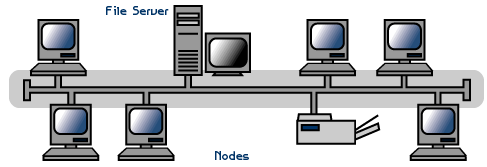I am really excited to write this entry ;D
when En. Razak thought about this topic, i felt like " OMG!, this subject is really interesting. ;) "
sooooooo! i want to share with u guys about
TECHNOLOGY and TOPOLOGY ;D
NETWORK TOPOLOGY
-Think of a topology as a network's virtual shape or structure.
-It is divide to two type of network topology:
- physical topology
- logical topology
Physical topology
-The way that the workstations are connected to the network through the actual cables that transmit data
- the physical structure of the network
• Types/Classification of physical topologies
– Linear Bus
– Star
– Star-Wired Ring
– Tree
– FDDI
– Mesh
Linear bus
A linear bus topology consists of a main run of cable with a terminator at each end (See fig. 1). All nodes (file server, workstations, and peripherals) are connected to the linear cable.
 Fig. 1. Linear Bus topology
Fig. 1. Linear Bus topologyAdvantages of a Linear Bus Topology
- Easy to connect a computer or peripheral to a linear bus.
- Requires less cable length than a star topology.
Disadvantages of a Linear Bus Topology
- Entire network shuts down if there is a break in the main cable.
- Terminators are required at both ends of the backbone cable.
- Difficult to identify the problem if the entire network shuts down.
- Not meant to be used as a stand-alone solution in a large building.
STAR
A star topology is designed with each node (file server, workstations, and peripherals) connected directly to a central network hub, switch, or concentrator (See fig. 2).
Data on a star network passes through the hub, switch, or concentrator before continuing to its destination. The hub, switch, or concentrator manages and controls all functions of the network. It also acts as a repeater for the data flow. This configuration is common with twisted pair cable; however, it can also be used with coaxial cable or fiber optic cable.
 Fig. 2. Star topology
Fig. 2. Star topologyAdvantages of a Star Topology
- Easy to install and wire.
- No disruptions to the network when connecting or removing devices.
- Easy to detect faults and to remove parts.
Disadvantages of a Star Topology
- Requires more cable length than a linear topology.
- If the hub, switch, or concentrator fails, nodes attached are disabled.
- More expensive than linear bus topologies because of the cost of the hubs, etc.
STAR-WIRED RING
The advantage of star-wired ring
A tree topology combines characteristics of linear bus and star topologies. It consists of groups of star-configured workstations connected to a linear bus backbone cable (See fig. 3). Tree topologies allow for the expansion of an existing network, and enable schools to configure a network to meet their needs.  Fig. 3. Tree topology Fig. 3. Tree topologyAdvantages of a Tree Topology
Disadvantages of a Tree Topology
FDDI In an FDDI LAN, the nodes that can be the source or destination of data frames are called stations. A station has a MAC layer, one or more MAC addresses, and one or more FDDI ports. The stations share the bandwidth provided by the ring. As was the case for Token Ring, cabling management often is simplified by connecting stations to a concentrator (hub) unit. A concentrator can play its role invisibly. However, it will need a MAC layer and a MAC address if it is going to be configured or supervised via network management messages. In this case, it will have the status of a station, too. FDDI Station Types There are two main types of stations, class A which attach directly to dual rings; or class B which attach to a station acting as a concentrator. A concentrator is a specialized workstation that attaches to the ring and has multiple ports that allow attachment of other devices in a physical star configuration. These may be cascaded. )(1) A type of computer network in which all the computers are arranged (schematically) in a circle. A token, which is a special bit pattern, travels around the circle. To send a message, a computer catches the token, attaches a message to it, and then lets it continue to travel around the network. Also see token passing. For network diagrams, see Network Topology Diagrams in the Quick Reference section of Webopedia. (2) When capitalized, Token Ring refers to the PC network architecture developed by IBM. The IBM Token-Ring specification has been standardized by the IEEE as the IEEE 802.5 standard. TOKEN RING AND ETHERNET TOPOLOGY??? ENJOY READING....... ;'D | ||


